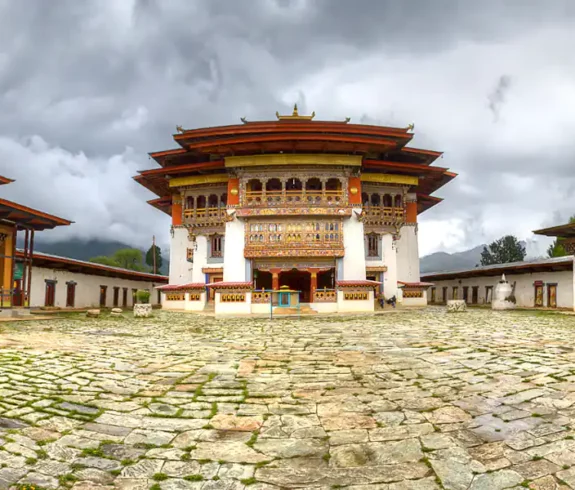The exquisite Gangtey Monastery welcomes you as you embark from the jaw-dropping landscapes of the Bhutanese highlands and descend through the clouds after completing the Gangtey Natural Trial. Once you get to the monastery, submerge yourself fully in its peace and rhythms. Trekking through the Phobjika Valley and its small rivers will be breathtaking.
Moreover, observe the monks and other Buddhists at this monastery as they practice meditation, ceremonial practices, and devotion. For the Bhutanese, Gangtey Monastery is the leading site of divinity, and it also draws a considerable number of visitors. More than that, this great monastery embodies Guru Rinpoche‘s heritage as well as the legacy of other gods.
Composition and Sequence of Gangtey Monastery
Gangtey Monastery has three different structures with five sanctuaries. All five sanctuaries encircle this monastery’s impressive Central Dome. After passing through the doorway, the temple complex of the monastery, known as the Tashokan, emerges. Tshokhang’s architects are reminiscent of the outstanding Tibetan-style woodwork and structures. The upper half of the monastery is made of lumber planks and colored with naturally occurring materials.

The hall is noted for having immense wooden pillars in Bhutan. After completely renovating it, the groups of monks and tribal elders gave this monastery a fresh identity. More than this, as you ascend to the second floor, you will see the stunning carvings and decorations accompanying the splendid hardwood windows. There will also be lovely sculptures of Guru Rinpoche and other idols. Gangtey Monastery also shelters the school and is crucial in offering a school system for the monks. The monastery is set in a convenient place in the Phobjika region.
Moreover, it is currently a large structure comprising the integral monastery, monks’ dwelling accommodations, contemplation spaces, and ritual performing halls. There are also exquisite mystical emblems and canvases at Gangtey Monastery’s shrines. Similarly, before approaching this majestic monastery, you must trek through an enchanting snow-covered hamlet.
History of Gangtey Monastery
In 1619, Pema Lingpa’s grandson “Rigdinz Pema Tinley” gave the Gangtey Monastery an idyllic life. Pema’s grandson started this to teach children and young people about spirituality, harmony, peace, and legion. The windows and doors were designed with the incredible craftsmanship of native woods to commemorate the illustrious history of the Buddhist religion.
It was initially erected as a Lhakhang, a small rural monastery, but was later upgraded by Rigdinz’s son Tenzing Legpaye Dhoendup, resembling a fortress. Likewise, The initial portrayal pertinent to this monastery represents Guru Rinpoche, who had a significant role in formulating the “Vajrayana” form of Buddhism and transforming Bhutan into Buddhism. Each winter, it is believed that Black-Neck Cranes, on their migratory route, follow a circular pattern in the monastery before making their way to the ravine.

Moreover, before they take a summertime journey back to Tibet, each year on November 11th, Gangtey Monastery hosts the Black Neck Cranes Festival each year. In the same way, the 2008 earthquake significantly impacted a large chunk of this monastery, which was eventually renovated and rebuilt. Even today, the stunning monastery’s original details are still in place.
